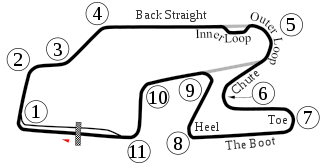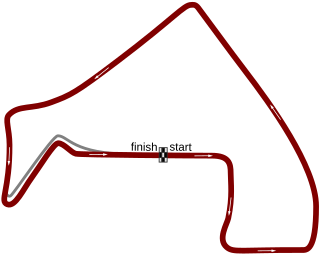Related Research Articles

The Nürburgring is a 150,000 person capacity motorsports complex located in the town of Nürburg, Rhineland-Palatinate, Germany. It features a Grand Prix race track built in 1984, and a much longer Nordschleife "North loop" track which was built in the 1920s around the village and medieval castle of Nürburg in the Eifel mountains. The north loop is 20.830 km (12.943 mi) long and has more than 300 metres of elevation change from its lowest to highest points. Jackie Stewart nicknamed the old track "The Green Hell".

Watkins Glen International, nicknamed "The Glen", is an automobile race track located in the town of Dix just southwest of the village of Watkins Glen, New York, at the southern tip of Seneca Lake. It was long known around the world as the home of the Formula One United States Grand Prix, which it hosted for twenty consecutive years (1961–1980). In addition, the site has also been home to road racing of nearly every class, including the World Sportscar Championship, Trans-Am, Can-Am, NASCAR Cup Series, the International Motor Sports Association and the IndyCar Series. The facility is currently owned by NASCAR.

The Caesars Palace Grand Prix was a car race held in Las Vegas between 1981 and 1984. For the first two years, the race was part of the Formula One World Championship, before becoming a round of the CART series in 1983. Nissan/Datsun was a presenting sponsor of both races.
Warwick Brown is a former racing driver from Australia.
Chaparral Cars was a pioneering American automobile racing team and race car developer that engineered, built, and raced cars from 1963 through 1970. Founded in 1962 by American Formula One racers Hap Sharp and Jim Hall, it was named after the roadrunner, a fast-running ground cuckoo also known as a chaparral bird.

Alvah Robert "Al" Holbert was an American automobile racing driver who was a five-time champion of the IMSA Camel GT series. He once held the record with the most IMSA race wins at 49.

During its history, Alfa Romeo has competed successfully in many different categories of motorsport, including Grand Prix motor racing, Formula One, sportscar racing, touring car racing and rallies. They have competed both as a constructor and an engine supplier, via works entries and private entries. The first racing car was made in 1913, three years after the foundation of A.L.F.A., the 40/60 HP had 6-litre straight-4 engine. Alfa Romeo quickly gained a good name in motorsport and gave a sporty image to the whole marque.

The Circuit Trois-Rivières is a street circuit located in Trois-Rivières, Quebec, Canada. The circuit has been the home of the annual Grand Prix de Trois-Rivières, the longest-running street race in North America, since 1967. The circuit is located on the Terrain de l'Exposition (fairgrounds) and is unusual in that it passes through Porte Duplessis, the narrow concrete gateway of the grounds at turn 3.

Edmonton International Speedway, also known as Speedway Park, was a 251-acre (1.02 km2) multi-track auto racing facility located in the present Cumberland and Hudson neighbourhoods of Edmonton, Alberta, Canada. The facility featured a 1⁄4-mile (400 m) dragstrip, a 2.53-mile (4.07 km) 14-turn road course, and a 1⁄4-mile short oval. At its peak, it had capacity for over 30,000 fans.

Ford Performance is the high-performance division of the Ford Motor Company and the multinational name used for its motorsport and racing activity.
Michael Roe is a former racing driver from Naas, Ireland.
The 1981 Can Am series season was the fourteenth running of the Sports Car Club of America's prototype-based series, and the fifth running of the revived series. Geoff Brabham was declared champion, despite only winning two races. Chevrolet again dominated the season. The dominant chassis manufacturers were March, Lola, Holbert, Frissbee, and VDS. IndyCar drivers Al Unser and Bobby Rahal also podiumed at Road America and Mosport, respectively.
The 1982 Can Am Series season was the fifteenth running of the Sports Car Club of America's prototype series, and the sixth running of the revived series. 1982 brought new competition for Chevrolet in the form of Hart and Cosworth. Hart would podium in three races while Cosworth would podium in two. The most dominant chassis were Frissbee, Marguey, March, VDS-001, and Ensign. Al Unser, Jr. would win at Road Atlanta, Laguna Seca, and Mosport twice, with a podium at Mid Ohio, at Riverside, and at Caesar's Palacae. Unser would be declared champion.
The 1983 Can Am season was the sixteenth running of the Sports Car Club of America's prototype series and the seventh of the revived series. 1983 marked the second year of Chevrolet having major competition, with Cosworth taking second at Mosport, first at Lime Rock, second at Trois-Rivières, first at the second race at Mosport, and second at Sears Point. Hart would take third at Lime Rock and third at Trois-Rivières. Porsche would get its first podiums this season, with a win at Road America and third at the second race at Mosport. The dominant chassis were Frissbee, Ensign, Lola, VDS, Scandia, and Ralt. Jacques Villeneuve, Sr. was declared champion, with podiums in almost every race. He would, however, become the final major racecar driver to win a Can Am championship.
The 1984 Can Am season was the seventeenth running of the Sports Car Club of America's prototype series, and the eighth running of the revived series. 1984 would mark a major downturn in the series, as Juan Manuel Fangio II would become the last major driver to podium in a Can Am Series race, finishing third at Dallas. The dominant manufacturers were Chevrolet, Hart, BMW for the first time with a third-place finish at Brainerd, Cosworth, Lola, Ralt, and March. Dominant chassis were VDS, March, Frissbee-Lola, Ralt, and Williams with their first podium with a third-place finish at Lime Rock. Michael Roe was declared champion, with seven wins. The final race at Green Valley would feature the final truly notable driver in series history, John Andretti.
The March 847 was a British sports prototype racing car, built by March Engineering in 1984 for the Can-Am series. As with all other full-size Can-Am cars of the time, it used a mid-mounted 5-litre, naturally-aspirated Chevrolet V8 engine. It was driven by Jim Crawford for RK Racing/United Breweries, scoring 3 wins. Jim Crawford and the March 847 chassis would both successfully finish the championship as runner-up at the end of the season.
The Lola T530 is a purpose-built Can-Am sports prototype, designed by British manufacturer Lola Cars in for the revived Can-Am series 1980. It was very successful, winning 7 of the 9 races in its first season of competition alone, and gave Patrick Tambay the championship with Carl A. Haas racing Team. Geoff Brabham won the championship in 1981; despite only winning 2 races. It was used in Can-Am racing until 1983. It was later used in the international Interserie racing series, and the British Thundersports racing series, between 1984 and 1988. Between 1980 and 1988, it scored a total of 32 race wins, and 43 podium finishes; a very impressive tally indeed. As with all other full-size Can-Am cars of the time, it used a mid-mounted 5-liter, naturally-aspirated, Chevrolet V8 engine. A total of 10 chassis' were built.
The VDS-001 was an American closed-wheel sports prototype race car, designed, developed, and built by Racing Team VDS for the revived Can-Am series, in 1981. It is based on the Lola T530. Geoff Brabham won the 1981 Can-Am Championship with the car, despite only winning 2 of the 10 races that season. It won a further 4 races in 1982 Can-Am Championship in 1982, being driven by Al Holbert. It was later exported to England, where it competed in the British Thundersports series, and achieved great success. Its sports car racing career spanned 9 years (1981-1988), and over that period of time, it won a total of 19 races, and achieved a total of 26 podium finishes. As with most Can-Am cars of the time, it was powered by a 5.0 L (310 cu in) Chevrolet small-block motor.
The VDS-003 was an American closed-wheel sports prototype, designed, developed and built by Racing Team VDS in 1983. It had only one sports car racing outing; the 1983 Lime Rock Park Can-Am round. It was driven by Phil Compton for Norwood-Walker Racing, but was involved in an accident during the practice session for the race. Therefore, it started in last place, and did not start the race. It was later decided to retire the car, and replace it with the much more successful 002, in which driver Michael Roe the championship in the next year. Just like its predecessors, it was powered by a Chevrolet small-block motor.
The VDS-004 was an American closed-wheel sports prototype race car, designed, developed, and built by Racing Team VDS for the revived Can-Am series, in 1984. It debuted at the fifth race of the 1984 season, at Road Atlanta. Michael Roe won the 1984 Can-Am Championship outright in the car, and together with the VDS-002, won a total of 7 of the 10 races that season. As with most Can-Am cars of the time, it was powered by the commonly used 5.0 L (310 cu in) Chevrolet small-block motor.
References
- ↑ "Michael Roe". www.ultimateracinghistory.com.
- ↑ "VDS-002" . Retrieved 20 June 2022.
- ↑ "VDS-002" . Retrieved 20 June 2022.
- ↑ Brown, Allen. "Can-Am 1984 « OldRacingCars.com". OldRacingCars.com.